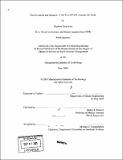The evolution prospects of the post-OPA90 Alaskan Oil Trade
Author(s)
Fox, Matthew Ryan
DownloadFull printable version (8.868Mb)
Other Contributors
Massachusetts Institute of Technology. Dept. of Ocean Engineering.
Advisor
Henry S. Marcus.
Terms of use
Metadata
Show full item recordAbstract
In response to the grounding of the Exxon Valdez on March 24, 1989, the United States Congress enacted the Oil Pollution Act of 1990, a series of regulations requiring technical and operational changes in tank vessels trading in U.S. waters with the intention of preventing future spills. Although the effects of OPA90 have been felt worldwide, vessels serving the Trans-Alaska Pipeline System have been particularly affected by the legislation. Trading between Valdez, Alaska and West Coast U.S. ports the TAPS trade is one of the few routes actively plied by Jones Act vessels. The age and design of the vessels engaged in the trade will require that many be phased out in accordance with OPA90 regulations in the coming years. Fleet capacity accounting for mandatory vessel phase outs is analyzed with respect to various crude production estimates for years 2000 to 2020. Potential design changes that may extend these vessels' trading lives are discussed. Shipyard capacity and factors affecting construction of ships in American yards are reported as well as the status of U.S. government programs designed to support the U.S.-flag fleet. Additionally, the potential impact that construction of ten 46,000 DWT product tankers may have on trade capacity is considered. The schedule at which these vessels must be delivered in order to meet Alaskan production estimates through 2039 is analyzed.
Description
Thesis (S.M.)--Massachusetts Institute of Technology, Dept. of Ocean Engineering, 2005. Some leaves folded. Includes bibliographical references (leaves 59-63).
Date issued
2005Department
Massachusetts Institute of Technology. Department of Ocean EngineeringPublisher
Massachusetts Institute of Technology
Keywords
Ocean Engineering.